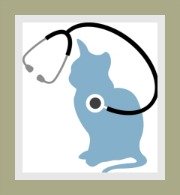Feline Calicivirus (FCV)
Cause, Symptoms and Treatment
Feline Calicivirus (FCV) and Feline Herpes are responsible for the most important feline upper respiratory diseases and is often referred to as feline influenza.
The difficulty with the FCV is that there are many different strains of the virus.
Very often, Feline Herpes Virus(FHV) is seen in combination with FCV and other viral and bacterial infections i.e. Bordetella Bronchiseptica and Feline Chlamydia.
FCV that causes feline respiratory disease may be asymptomatic (cause no symptoms) or be characterized by mild to severe symptoms.
symptoms of calicivirus
The incubation period (i.e. the time is takes from exposure to the disease to the appearance of the first signs) is between 2 and 6 days.
The symptoms will vary depending on the strain of the virus, the age and general health of the cat and the amount of virus the cat has been exposed to.
Calicivirus in cats affects the
eyes and upper respiratory tract (i.e. the nose, throat, pharynx,
larynx).
General malaise and lethargy: The cat will be sluggish and depressed
Raised Temperature: Kitty will have a high temperature of around 105°F (40°C)
Sneezing: Frequent and persistent sneezing. Not every sneeze is cat flu!
Cats do occasionally sneeze and this may be due to a simple irritant (dust, pollen, smoke) or in the case of frequent sneezing due to fungal or bacterial infections or it may be a symptom of nasal tumors.
Rhinitis: Is an inflammation of the nose.
There is a nasal discharge which starts off as watery and clear and as the feline respiratory disease progresses, the discharge becomes thick and muco-purulent (full of mucus and yellow pus).
The nostrils will become crusted and blocked making it difficult for the cat or kitten to breathe. (The nasal discharge may also have traces of blood present)
Conjunctivitis: An inflammation of the conjunctiva (mucus membranes of the inner eyelids) characterized by swollen and red eyes.
The eye discharge starts off as watery and clear and as the disease progresses, the discharge become thick and muco-purulent (full of mucus and yellow pus).
Coughing: The cat will cough and wheeze and generally have difficulty in breathing.
Excess saliva: The cat may also produce large amounts of saliva which makes the cat drool.
Stomatitis: This is an inflammation of the mouth and tongue and may be accompanied by severe and painful ulcers.
These ulcers will also be found around the mouth and nose.
These ulcers start off as little blisters, which then burst and become ulcerated.
The mouth ulcers coupled with the blocked nose is possibly the reason why the cat will not eat.
Loss of appetite
General
Certain strains of the Feline Calicivirus may, if untreated, go on to cause pneumonia - an infection of the lungs.
Some strains of Feline Calicivirus may cause impaired movement whilst others cause swelling of the paws and face.
There are certain strains of the virus that cause skin lesions and skin ulceration.
The cat will become susceptible to a host of secondary infections and suffer severe weight loss.
Symptoms
may last for 6 - 10 days in the case of a mild infection, and in
untreated and severe cases symptoms may be present for up to 6 weeks.
transmission of feline calicivirus
As the Calicivirus is found in discharges from the eyes, nose and saliva of a cat with the disease.
It goes without saying that the disease can be spread by direct contact or by droplet infection (coughing and sneezing).
The virus can survive outside the body in the environment for a week or more. This means that an infected cat's bedding, toys and feeding dishes also present a source of infection.
The virus is also transmitted by humans when they handle sick cats and do not wash their hands or do not wear protective clothing or if contaminated clothing is not removed after touching an infected cat.
Finally, 'carriers' (cats that have had the disease and have recovered) who are in good health, may shed the virus when they are under physical and emotional stress thereby infecting healthy cats with the virus.
diagnosis
An experienced veterinarian will be able to identify 'cat flu' at a glance.
In order to diagnose the causal organism, the vet will need to take a swab of the cat's throat and send it off for examination at a veterinary laboratory.
It is important to determine the cause, as Bordetella Bronchiseptica and Feline Herpes Virus present with very similar symptoms.
cats at risk
Feline Calicivirus is a highly contagious viral disease.
Whilst the disease can strike at any time, kittens, un-vaccinated cats and older cats are at greatest risk.
Other high risk groups include:
- Immuno-compromised cats that includes cats receiving chemotherapy of those suffering from Feline Aids or Feline Leukemia Virus (FeLV)
- Cats that live in large groups e.g. feral cats, or cats in rescue shelters or catteries are also high risk.
feline calicivirus treatment
There is no specific treatment for this viral disease.
Treatment is symptomatic - treating the individual symptoms coupled with intensive nursing care and lots of TLC.
For the treatment of Calicivirus please follow directions for Cat Flu treatment.
prognosis
If the disease is caught early and treated immediately and the pet owner provides intensive nursing care, the chances of survival are excellent.
Many cats do recover from the symptoms, but do go on to develop a life-long chronic rhinitis which is sometimes referred to as Snuffles.
Some also become 'Carriers' of Feline Calicivirus.
The mortality (death) rate is highest in older, geriatric cats, young kittens and immuno-compromised cats.
feline calicivirus prevention
Vaccination is the only way to prevent your cat or kitten from contracting FCV.
The chapter on cat vaccinations provides a schedule of all the highly recommended vaccines.
Cats that present with Feline Calicivirus symptoms should be isolated from healthy cats to prevent the spread of the disease.
Related Pages:
Top of Feline Calicivirus Page
Return to Cat Flu
search our site
please like us
share our site
recommend on google
favorite pages





